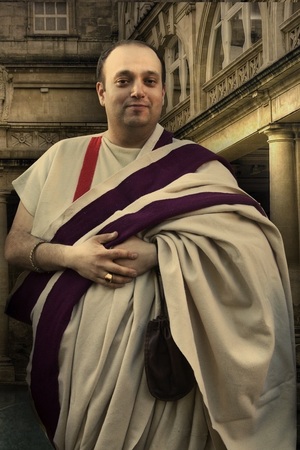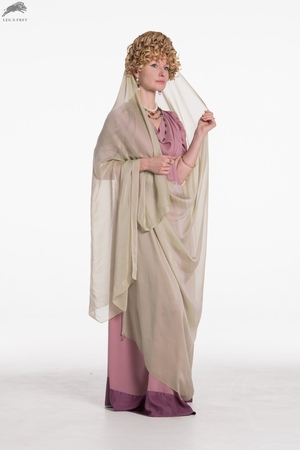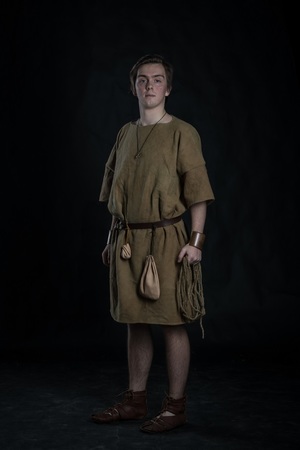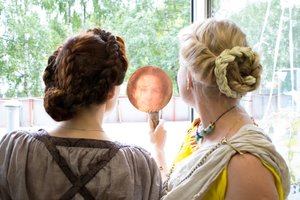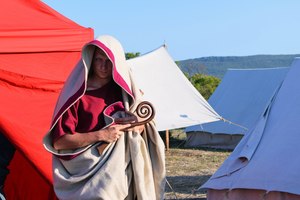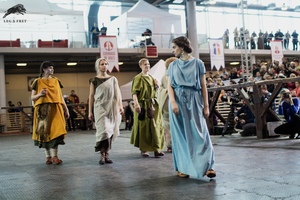Quirits of Rome - literature
This section is dedicated to useful literary materials related to the direction of "Quirites of Rome".
Main reenactment images of the direction:
- Roman citizens of the patrician class (aristocrats, matrons, senators)
- Priests (vestal virgins, pontiffs, priestesses of Isis)
- Plebeians (craftsmen, merchants, ordinary inhabitants of the empire)
- Slaves
For information on peaceful female images, you can refer to the section on Women in Ancient Rome, and for male images, refer to Men in Ancient Rome.
Recommended literature on the subject
In Russian:
Life of the Greeks and Romans-Velishsky.pdf
This edition of the famous work by F.F. Velishsky, "Everyday Life of Greeks and Romans," was published in 1878 in Prague by the Typography of I.Militkiy and Novak. The texts are informative, with numerous illustrations and references to ancient culture, with Latin and Greek translations, convincing us that meticulous ethnographic, historical, and philological work has been done. The collected materials from the lives of Greece and Rome can satisfy even the most demanding researcher of antiquity. Chronological and historical tables of Greece and Rome, military documents and descriptions of gladiatorial battles, festivals and religious ceremonies, the history of architecture, sports, and education provide comprehensive answers to questions for both experts in antiquity and general readers.
The Life of Ancient Rome-Sergeenko. pdf
The book by ancient history historian M.E. Sergeenko is based on lectures given by the author in 1958-1961 and was first published in 1964 under the auspices of the USSR Academy of Sciences. It immediately became one of the main textbooks for history students specializing in Roman history. The work is mainly devoted to the everyday life of Rome and its inhabitants. M.E. Sergeenko thoroughly examines archaeological finds, testimonies of ancient authors, and other monuments to recreate the customs and worldview of the ancient Romans. Although the material is strictly scientific, the text of the book is written in an accessible manner, without an overload of specialized terminology, as the author aimed to familiarize our readers with the everyday life of ancient Rome - after all, without understanding it, one cannot fully comprehend Roman literature or the history of Rome in general.
History of the peasantry in Ancient Rome-Shterman. pdf
This book comprehensively explores the little-studied history of ancient Roman peasantry as a distinct social and class category of society. The time period of the study is significant, ranging from the Early Republic (6th-5th centuries BCE) to the establishment and flourishing of the Roman Empire (1st-4th centuries CE). The book raises global issues such as the genesis and flourishing of the peasant system as the backbone of ancient Roman civitas (polis) and the foundation of the power of the Roman state; the origin and changes in the social composition of the peasantry, its place and leading role in Roman civilization; peasant ideology and religious cults; the decay of peasantry in the Imperial period - Roman "farming" and colonate. These and many other issues are vividly presented in the context of living history and reveal the diversity of the material and spiritual world of Roman peasantry, and in essence, the entire ancient Roman society and state.
Roman censors and urban planning in Italy-Kucherenko. pdf
The activities of Roman censors in Italian urban planning demonstrate their significant contribution to the urbanization of Italy. The goals and nature of construction were determined by the challenges facing Rome in this new period of its history. The spread of Roman influence and the Roman way of life in the Apennines also influenced the censors' involvement in construction. Their activities in this field were quite diverse. In most cases, their work had a utilitarian character and involved the construction of bridges and aqueducts, roads, market organization, and public buildings. However, fortifications and temples were rarely encountered. The censors enjoyed freedom in the allocation and expenditure of funds, as they were involved in Rome's financial affairs. While the censors were generally diligent in performing their duties, there were cases of financial indiscipline and moral transgressions.
Religion and power in the Roman Republic Magistrates priests Morel temples. pdf
Roman Censors and Urban Planning in Italy-Kucherenco.pdf
The activities of Roman censors in Italian urban planning demonstrate their significant contribution to the urbanization of Italy. The goals and nature of construction were determined by the challenges facing Rome in this new period of its history. The spread of Roman influence and the Roman way of life in the Apennines also influenced the censors' involvement in construction. Their activities in this field were quite diverse. In most cases, their work had a utilitarian character and involved the construction of bridges and aqueducts, roads, market organization, and public buildings. However, fortifications and temples were rarely encountered. The censors enjoyed freedom in the allocation and expenditure of funds, as they were involved in Rome's financial affairs. While the censors were generally diligent in performing their duties, there were cases of financial indiscipline and moral transgressions.
Religion and Power in the Roman Republic Magistrates, Priests, Temples-Smorchkov.pdf
This work provides a comprehensive analysis of the role of religion in the political system of the Roman Republic. It extensively examines issues such as the sacred content of magisterial power, religious authority of the highest magistracies (consuls, dictators, censors), the political significance and influence of priests (pontiffs and augurs), the involvement of religious and political bodies in the establishment of temples, and the status of temples in the Roman socio-political organization. The key focus of the study is the examination of the right to public auspices (divination), which expressed the religious-political unity of the republican state structure. The interaction between religion and power is closely examined in relation to the specificities of Roman society and its worldview.
In foreign languages:
The Emperor 39s Clothes The Fold Lines - Hero Granger Taylor.pdf
Emperor's Clothing: Fold Lines. Analysis of statues and fabrics.
In this volume, the latest research and findings provide a deeper understanding of religious practices in Republican Rome and contemporary Central-Italic societies, including the Etruscans, during the Middle and Late Republic periods. While many recent studies have focused on the Romanization of areas outside Italy in later periods, this volume explores the religious aspects of Romanization within the Italian peninsula itself. The chapters aim to combine literary evidence with archaeological and epigraphic material as they examine the relationship between religion and politics in early Italy, the influence of Roman institutions and practices on Italic society, the reciprocal influence of non-Roman practices and institutions on Roman customs, and the nature of "Roman" religion in contrast to "Latin," "Italic," or "Etruscan" religion during the period under consideration. The final volume sheds light on various aspects of religious practice in Republican Italy while simultaneously complicating the categories we employ to discuss it.
Roman Religion in Archaic and Republican Rome.pdf
As Rome extended its influence over the whole of Italy, gradually involving its various peoples in the processes of Romanization and conquest, its religion was heavily influenced by the cults and religious practices of its new subjects and citizens. This was a period of intense religious ferment and creativity. Roman religion, controlled and defined by religious and political functionaries who served as intermediaries between the people, centered on a select pantheon of gods with Jupiter at the helm. It was a state-serving religion, no matter how genuine its priests and devotees may have been. Understanding the dynamics of religious change is fundamental to comprehending the evolving culture and politics of Rome during the last five centuries BCE. Religion in Archaic and Republican Rome tells this story.

 Gallery
Gallery






